#safety glass manufacturer
Text
Frequently Asked Questions About Toughened Glass
1. What is toughened glass? Toughened glass, also known as tempered glass, is a type of safety glass that is processed through controlled thermal or chemical treatments to increase its strength. It is significantly stronger and safer than regular glass, as it shatters into small, blunt pieces upon impact, reducing the risk of injury.
2. What are the advantages of toughened glass? Toughened glass offers several benefits, including enhanced safety, durability, thermal resistance, and strength. It is ideal for various applications, such as doors, windows, facades, shower enclosures, and automotive windows, where safety and durability are paramount.
3. How is toughened glass manufactured? Toughened glass undergoes a specialized heating and rapid cooling process, known as tempering, which strengthens its molecular structure. This process involves heating the glass to a high temperature and then rapidly cooling it to induce surface compression and internal tension, resulting in increased strength and safety.
4. What are the applications of toughened glass? Toughened glass is used in a wide range of applications, including residential, commercial, and automotive sectors. It is commonly used for doors, windows, partitions, balustrades, shower enclosures, glass facades, tabletops, and automotive windows due to its strength, safety, and aesthetic appeal.
5. Is toughened glass customizable? Yes, toughened glass can be customized to suit specific requirements in terms of size, thickness, shape, tint, and finishes. Manufacturers offer a variety of customization options to meet the diverse needs of customers for both functional and aesthetic purposes.
6. How does toughened glass enhance safety? Toughened glass is designed to reduce the risk of injury in the event of breakage. Unlike regular glass, which breaks into sharp shards, toughened glass shatters into small, blunt pieces that are less likely to cause serious harm. This property makes it a preferred choice for applications where safety is paramount.
7. Is toughened glass suitable for use in extreme temperatures? Yes, toughened glass exhibits excellent thermal resistance and can withstand sudden temperature changes without cracking or breaking. It is suitable for use in areas exposed to high temperatures, such as kitchen splashbacks, oven doors, and glass facades.
8. How can I clean and maintain toughened glass? Toughened glass is relatively easy to clean and maintain. You can use a mild detergent or glass cleaner with a soft cloth or sponge to remove dirt and stains. Avoid using abrasive materials or harsh chemicals, as they can damage the glass surface. Regular cleaning and maintenance will help preserve the clarity and appearance of toughened glass over time.
9. What quality standards should I look for when purchasing toughened glass? When purchasing toughened glass, look for products that meet industry standards and certifications for safety glazing materials. Ensure that the manufacturer adheres to quality control measures and conducts rigorous testing to ensure the strength, durability, and safety of their products.
10. Where can I purchase toughened glass in Mysore? You can purchase top-quality toughened glass products from reputable manufacturers and suppliers in Mysore. Look for companies that have a proven track record of delivering high-quality products and excellent customer service to meet your specific requirements.
Author - JP Art & Safety Glass


#Toughened glass#Tempered glass#Safety glass#Glass manufacturing#Glass fabrication#Toughened glass suppliers#Toughened glass products#Glass industry#Custom glass#Architectural glass#Commercial glass#Residential glass#Automotive glass#Glassworks#Glass fabrication company#Glass manufacturer#Glass supplier#Toughened glass production#Quality glass products#Mysore glass manufacturers
0 notes
Text
The Ocean Sciences Building at the University of Washington in Seattle is a brightly modern, four-story structure, with large glass windows reflecting the bay across the street.
On the afternoon of July 7, 2016, it was being slowly locked down.
Red lights began flashing at the entrances as students and faculty filed out under overcast skies. Eventually, just a handful of people remained inside, preparing to unleash one of the most destructive forces in the natural world: the crushing weight of about 2½ miles of ocean water.
In the building’s high-pressure testing facility, a black, pill-shaped capsule hung from a hoist on the ceiling. About 3 feet long, it was a scale model of a submersible called Cyclops 2, developed by a local startup called OceanGate. The company’s CEO, Stockton Rush, had cofounded the company in 2009 as a sort of submarine charter service, anticipating a growing need for commercial and research trips to the ocean floor. At first, Rush acquired older, steel-hulled subs for expeditions, but in 2013 OceanGate had begun designing what the company called “a revolutionary new manned submersible.” Among the sub’s innovations were its lightweight hull, which was built from carbon fiber and could accommodate more passengers than the spherical cabins traditionally used in deep-sea diving. By 2016, Rush’s dream was to take paying customers down to the most famous shipwreck of them all: the Titanic, 3,800 meters below the surface of the Atlantic Ocean.
Engineers carefully lowered the Cyclops 2 model into the testing tank nose-first, like a bomb being loaded into a silo, and then screwed on the tank’s 3,600-pound lid. Then they began pumping in water, increasing the pressure to mimic a submersible’s dive. If you’re hanging out at sea level, the weight of the atmosphere above you exerts 14.7 pounds per square inch (psi). The deeper you go, the stronger that pressure; at the Titanic’s depth, the pressure is about 6,500 psi. Soon, the pressure gauge on UW’s test tank read 1,000 psi, and it kept ticking up—2,000 psi, 5,000 psi. At about the 73-minute mark, as the pressure in the tank reached 6,500 psi, there was a sudden roar and the tank shuddered violently.
“I felt it in my body,” an OceanGate employee wrote in an email later that night. “The building rocked, and my ears rang for a long time.”
“Scared the shit out of everyone,” he added.
The model had imploded thousands of meters short of the safety margin OceanGate had designed for.
In the high-stakes, high-cost world of crewed submersibles, most engineering teams would have gone back to the drawing board, or at least ordered more models to test. Rush’s company didn’t do either of those things. Instead, within months, OceanGate began building a full-scale Cyclops 2 based on the imploded model. This submersible design, later renamed Titan, eventually made it down to the Titanic in 2021. It even returned to the site for expeditions the next two years. But nearly one year ago, on June 18, 2023, Titan dove to the infamous wreck and imploded, instantly killing all five people onboard, including Rush himself.
The disaster captivated and horrified the world. Deep-sea experts criticized OceanGate’s choices, from Titan’s carbon-fiber construction to Rush’s public disdain for industry regulations, which he believed stifled innovation. Organizations that had worked with OceanGate, including the University of Washington as well as the Boeing Company, released statements denying that they contributed to Titan.
A trove of tens of thousands of internal OceanGate emails, documents, and photographs provided exclusively to WIRED by anonymous sources sheds new light on Titan’s development, from its initial design and manufacture through its first deep-sea operations. The documents, validated by interviews with two third-party suppliers and several former OceanGate employees with intimate knowledge of Titan, reveal never-before-reported details about the design and testing of the submersible. They show that Boeing and the University of Washington were both involved in the early stages of OceanGate’s carbon-fiber sub project, although their work did not make it into the final Titan design. The trove also reveals a company culture in which employees who questioned their bosses’ high-speed approach and decisions were dismissed as overly cautious or even fired. (The former employees who spoke to WIRED have asked not to be named for fear of being sued by the families of those who died aboard the vessel.) Most of all, the documents show how Rush, blinkered by his own ambition to be the Elon Musk of the deep seas, repeatedly overstated OceanGate’s progress and, on at least one occasion, outright lied about significant problems with Titan’s hull, which has not been previously reported.
A representative for OceanGate, which ceased all operations last summer, declined to comment on WIRED’s findings.
5K notes
·
View notes
Text
airport ads are so fucking weird and intriguing. i saw one that was talking about a defense contractor partnership of companies with all these org logos and i'm like. hold up. Ball Canning?!

yes apparently?! what????
#i would love to know the story from A to B here because their site/wikipedia are very not transparent#and it's like. tracking. systems. satellites. weather. everything you can think of???#and i know we have NASA to thank for improved canning safety and such#so is that related?#or maybe glass/aluminum manufacturing?#but then how do you get to like. We Make Satellites Now#?????????????#corporatism is so goddamn weird.#(also this is probably not news to anybody who is Into Canning but Ball licenses the canning brand nowadays. they don't do jars anymore)#(lol)
1 note
·
View note
Text
World Sight Day
#pharmacovigilance#regulatory#drugsafety#healthcare#eyes#sight#eyesight#eyes safety#Glasses#pharma manufacturing#regulatoryaffairs
1 note
·
View note
Text
adventures in QA
(previous post in this series)
My shop in Advanced Midbody - Carbon Wing (AMCW) at Large Aircraft Manufacturer (LAM) is at the very end of the composite fabrication building. Hundreds of people carefully lay up a hundred foot long slab of carbon fiber, cure it, paint it, and then we totally fuck it up with out of spec holes, scrapes, primer damage, etc. The people who write up our many defects are from the Quality Assurance (QA) department.
Every single screw and rivet on a LAM aircraft can be traced back to the mechanic who installed it. Back when even everything was done in pen and pencil, it was joked that the paper used to produce an aircraft outweighed the plane itself. Now that everything is computer-based, of course, the amount of paperwork is free to grow without limit.
(Haunting the factory is endless media coverage of an emergency exit door plug popping out of an Advanced Smallbody - Upengine (ASU) plane during a routine flight a few months ago. Unlike that airframe's notorious problems with MCAS, this was a straightforward paperwork screwup by a line worker: the bolts were supposed to be tightened, and they weren't.
As a result the higher ups have visited hideous tribulations on non-salaried workers. Endless webinars, structured trainings. Here at the Widebody plant we have received a steady flow of refugees from the Narrowbody factory, hair-raising tales of receiving one hundred percent supervision from the moment they clock in to the second they clock out from FAA inspectors who can recommend actual jail time for any lapse in judgement.)
A single hydraulic bracket Installation Plan (IP) is around four brackets. The team leads generally assign two bracket IPs per mechanic, since each bracket set is something like a foot apart, and while working on the plane is bad enough it's much worse to have another mechanic in your lap.

Let me list the order of operations:
One: Find where you're supposed to install these brackets. This is harder than you might think.
Firstly, it's a hundred foot long plank of carbon fiber composite, with longitudinal stringers bonded to it to add stiffness. The stringers are pilot drilled in the trim and drill center, a truly Brobdingnagian CNC mill that trims off the composite flash at the edges and locates and drills part holes for us. But there's a lot of holes, so you must carefully find your set.
A minor difficulty is that the engineering drawings are laid out with the leading edge pointing up, while the wing panels in our cells hang from the trailing edge. Not so bad, you just rotate the paper 180 when orienteering, then rotate it back up to read the printed labels.
A major difficulty is that the drawings are from the perspective from the outside of the panel. But we work on the inside of the wing (obviously, that's where all the parts are installed) so we also flip the drawings and squint through the back of the paper, to make things line up.
Large Aircraft Manufacturer has a market cap of US$110 billion, and we're walking around the wing jig with sheets of paper rotated 180 and flipped turnways trying to find where to put brackets.
Oh well, we're paid by the hour.

Two: Match drill the aluminum brackets to the carbon fiber composite stringer. I can devote an entire post to the subtleties of drilling carbon fiber, but I can already tell that this post is going to be a miserable slog, so I will merrily skip over this step.
Three: Vacuum up all the carbon dust and aluminum swarf created during this process. This step is not optional, as your team lead will remind you, his screaming mouth clouding your safety glasses with spittle at a distance of four inches. LAM is very serious about FOD. Every jet airliner you've ever ridden in is a wet wing design-- each interstitial space is filled with Jet A. There is no fuel bladder or liner-- the fuel washes right over plane structure and wing hardware. Any dirt we leave behind will merrily float into the fuel and be sucked right into the engines, where it can cause millions in damage. No place for metal shavings!
If you are nervous about flying, avoid considering that all the hydraulic lines and engine control cables dip into a lake of a kerosene on their way from the flight deck to the important machines they command. Especially do not consider that we're paid about as much per hour as a McDonalds fry cook to install flight-critical aviation components.
Four: Neatly lay out your brackets on your cart, fight for a position at a Shared Production Workstation (SPW) (of which we have a total of four (4) for a crew of thirty (30) mechanics) and mark your IP for QA inspection as Ready To Apply Seal.
Four: Twiddle your thumbs. Similarly, we have three QA people for thirty mechanics. This is not enough QA people, as I will make enormously clear in the following steps.
Five: Continue waiting. Remember, you must not do anything until a QA person shows up and checks the box. Skipping a QA step is a “process failure” and a disciplinary offense. From the outside, you can observe the numerous QA whistleblowers and say “golly, why would a mechanic ever cut a corner and ignore QA?” Well...
Six: QA shows up. Theoretically, they could choose to pick up the mahrmax you prepared for them and gauge every single hole you've drilled. But since we're three hours into the shift and they're already twenty jobs behind, they just flick their flashlight across the panel and say “looks good" and then sprint away. Can't imagine why our planes keep falling out of the sky.

Seven: Apply the seal to the bracket. P/S 890 is a thick dark gray goop that adheres well to aluminum, carbon fiber, fabric, hair and skin. Once cured, it is completely immune to any chemical attack short of piranha solution, so if you get any on yourself you had better notice quick, otherwise it'll be with you as long as the layer of epidermis it's bonded to. LAM employees who work with fuel tank sealant very quickly get out of the habit of running their hands through their hair.
Eight: Now you wait again. Ha ha, you dumb asshole, you thought you were done with QA? No no, now you put up the job for QA inspection of how well you put the seal on the bracket. Twiddle your thumbs, but now with some urgency. The minute you took the bottle of seal out of the freezer, you started the clock on its "squeeze-out life." For this type of seal, on this job, it's 120 minutes. If QA doesn't get to you before that time expires, you remove your ticket, wipe off the seal, take another bottle out the freezer, and apply a fresh layer.
Nine: Optimistically, QA shows up in time and signs off on the seal. Well, you're 100 minutes into your 120 minute timer. Quickly, you slap the brackets onto the stringer, air hammer the sleeve bolts into position, thread nuts onto the bolts, then torque them down. Shove through the crowd and mark your IP "ready to inspect squeeze out"
Ten: Let out a long breath and relax. All the time sensitive parts are over. The criteria here is "visible and continuous" squeeze out all along the perimeter of the bracket and the fasteners. It is hard to screw this up, just glop on a wild excess of seal before installing it. If you do fail squeezeout, though, the only remedy is to take everything off, throw away the single-use distorted thread locknuts, clean everything up and try again tomorrow.
Eleven: QA approved squeeze out? Break's over, now we're in a hurry again. By now there's probably only an hour or two left in the shift, and your job now is to clean off all that squeeze out. Here's where you curse your past self for glopping on too much seal. You want to get it off ASAP because if you leave it alone or if it's too late in the shift and your manager does feel like approving overtime it'll cure to a rock hard condition overnight and you'll go through hell chipping it off the next day. You'll go through a hundred or so qtips soaked in MPK cleaning up the bracket and every surface of the panel within three feet.
Twelve: Put it up for final inspection. Put away all your tools. (The large communal toolboxes are lined with kaizen foam precisely cut out to hold each individual tool, which makes it obvious if any tool is missing. When you take a tool out, you stick a tool chit with your name and LAMID printed on it in its place. Lose a tool? Stick your head between your legs and kiss your ass goodbye, pal, because the default assumption is that a lost screwdriver is lurking in a hollow "hat" stringer, waiting to float out and damage some critical component years after the airplane is delivered.)
One tool you'll leave on your cart, however, is the pin protrusion gage. There is a minimum amount of thread that must poke outside of the permanent straight shank fastener's (Hi-Lok) nut, to indicate that the nut is fully engaged. That makes sense. But there's also a maximum protrusion. Why?
Well, it's an airplane. Ounces make pounds. An extra quarter inch of stickout across a thousand fasteners across a 30 year service life means tons of additional fuel burnt. So you can't use a fastener that's too long, because it adds weight.
On aluminum parts, it's hard to mess up. But any given composite part is laid up from many layers of carbon fiber tape. The engineers seemed to have assumed that dimensional variation would be normally distributed. But, unfortunately, we buy miles of carbon fiber at a time, and the size only very gradually changes between lots. When entire batches are several microns oversize, and you're laying up parts from fifty plies and an inch thick, you can have considerable variation of thickness on any given structural component. So you had better hope you had test fit all of your fasteners ahead of time, or else you'll be real sorry!
And, if you're really lucky, QA will show up five minutes before end of shift, pronounce everything within tolerance, then fuck off.
And that's how it takes eight hours to install eight brackets.
147 notes
·
View notes
Text
Lockwood & Co AU were agents have to wear armor to avoid ghost touch.

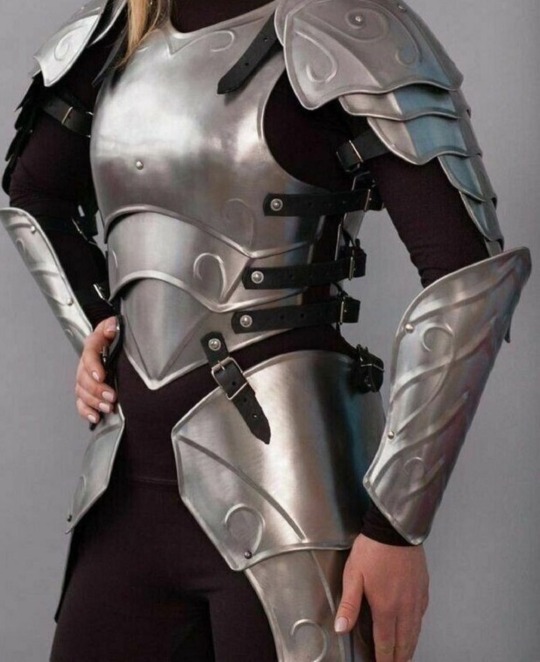
Fittes agents would have to wear a full armor, I'm talking helmet and everything. (Lockwood thinks they look like tin cans.)
They would claim its for safety reasons,
(we all know the real reason is to look superior and intimidating, but really, they just look ridiculous)
in reality, full armor is rather inconvenient when you are out fighting ghosts and not knights.
(idk why, but I feel like they would call themselves "the knights of Fittes" lol)
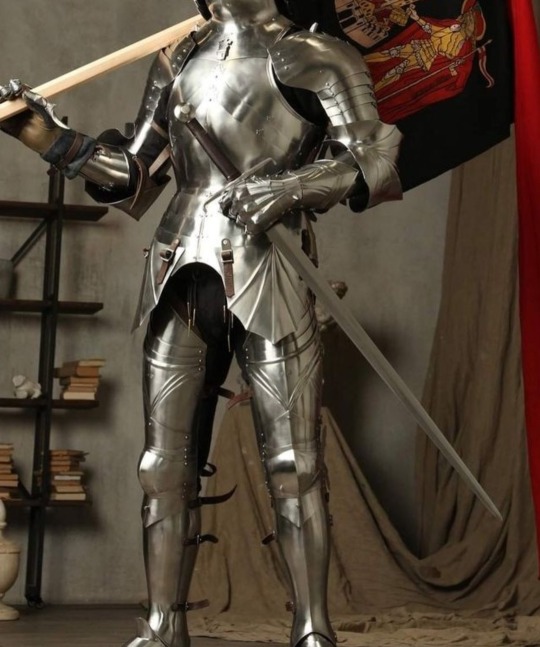
(Other agencies wouldn't provide their agents with full armor, usually just the necessities. That was only a thing Fittes and Rotwell did.)
Lockwood & Co, on the other hand;
George: He HATES armors. He hates how they look, how long it takes to put them on, and how they feel. More than once, he has tried to go out to a case without it, but Lockwood, being the mother hen that he is, won't allow it under any circumstance.
Parts of his armor (arms and legs) would be from his old Fittes armor that he stole when they fired him. And the rest would be homemade a.k.a Lockwood's design. (Yes, he made his own patent armor, more on that later).
George personalized it, of course, to be more comfy. He made it a dark grey color, unlike Anthony's. And he added extra pockets for salt bombs and flares... and maybe biscuits.
(Extra: he refuses to wear "the stupid knight shoes" and just wears his normal snickers. and he doesn't wear a helmet because he needs his glasses. and also, i couldn't find any armors with orange/yellow details, but just imagine it, ok?).

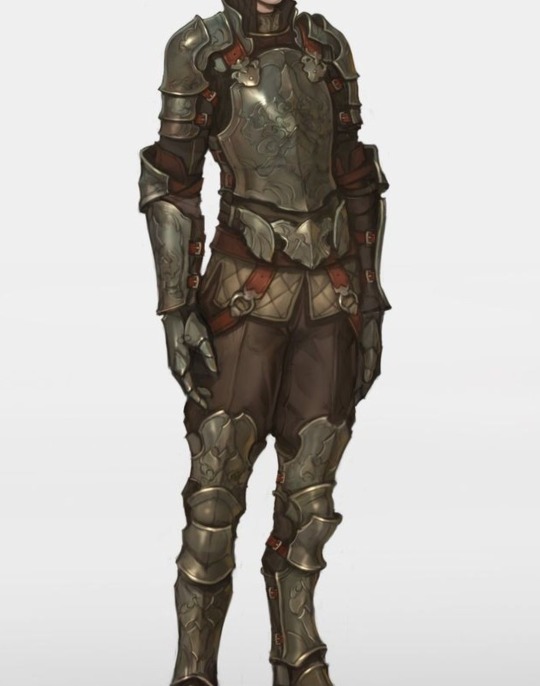
Anthony: He hated the traditional design of the Fittes armor. It draws the attention of ghosts too easily, it constantly gets in the way when he's fencing, and can you imagine trying to run with that thing on? awful. So, he made his own design with his parents money with his grand intelect.
He made it way more flexible on the joints, added some leather pockets, removed the shoes (George's request), and replaced that god-awful tin can color with something more discrete, black.
(Extra: he also doesn't wear a helmet, out of solidarity. he would incorporate his coat to his attire somehow. And imagine it black also lol).


Lucy: She didn't know how important armor was until she moved to London. Back home, all her and her team were given was a chest plate. So, when she only wore that old chest plate on her first case with L&C, Lockwood almost had a freak out. He immediately made a date with his manufacturer.
She was embarrassed and insisted that it wasn't necessary, but Lockwood was having NONE of it. After all, his team (LUCY) is his number 1. priority.
She incorporated her old chest plate into her armor. It had too many memories attached to it just to throw it away. So she also went with the dark grey color to match.
(Extra: Of course, the details on her armor are blue <3, and she also doesn't wear her helmet because neither George nor Anthony wore them, so, she didn't found out that they were a thing until she met Kipps and his team. Honestly, it was 100% more practical without the helmet).

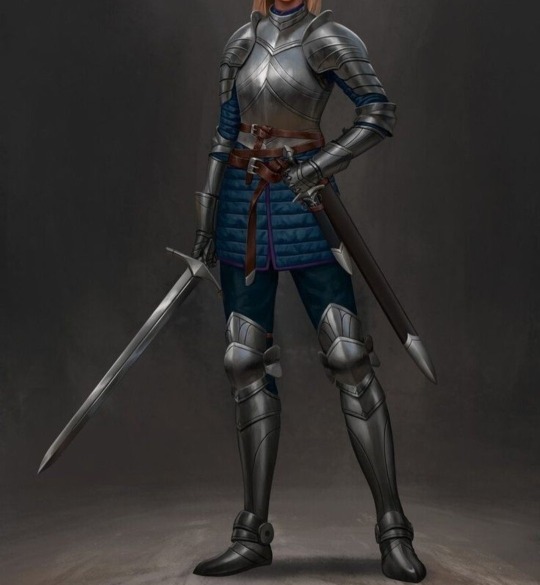
(I made this instead of studying for a very important test, send help)
#lockwood and co#lockwood & co#anthony lockwood#lucy carlyle#george karim#save lockwood & co#save lockwood and co#knight au#lockwood#l&co#save l&co#l&co. netflix#fuck netflix#locknation#lockwood & co netflix#lockwood netflix
249 notes
·
View notes
Text
protag johnny truant talks a lot abt his sex life and the girls he fucks, seemingly without a direct relation to what he footnotes. but theres always this weird dissociative vibe to it and a lot of ppl think he's lying to sound better than he is (smth he admits to having done, telling insane stories abt how he got his disfigurements is part of his (often unsuccesful) pickup routine), but i ask what does he have to lie about in footnotes no one is ever going to see? my theory is that they are things he thinks happened, or things he is afraid of happening, and writing them out is his way of assuaging the anxiety brought on by delusion or ocd
notably these alleged fantasies are not particularly flattering or satisfying. they are under bizarre or unideal circumstances, involve him feeling deeply ambivalent and lonely, and explicitly mentions not finishing. a woman he doesnt remember becoming friends with uses him as revenge sex on her fiancé. so i find it hard to believe hes doing it to bolster an image or even an ego. if they do happen, even in part, these are not healthy or even necessarily coping mechanisms that make him feel better. often they make him feel worse, lost, alone.
I won't deny that Johnny's parts can be hard to get through. He can be crass, misogynistic, uncomfortable, unhygenic, dissociative, painful, ugly, and sometimes there's just plain bad sex. But I think it's unfair to discount these sections as entirely discrete from and unrelated to Zampano's paper on The Navidson Record. Johnny's story is included in House of Leaves for a reason. It's a part of the whole. There's a lot to be said about Johnny, whose life has never had any security to begin with, whose life is a series of winding pathways that leave him substance reliant and unsure of his place in anything-- in space in time in other people's lives-- reading a book about a movie where this upper middle class nuclear family moves into a new house and immediately have their own sense of domestic safety completely and totally shattered.
Here he is, speaking about his disfigurements (the things he has to tell ludicrous, pulpy stories about in order for people to not recoil away from him):
"All of it true too, though of course scars are much harder to read. Their complex inflections do not resemble the reductive ease of any tattoo, no matter how extensive, colorful or elaborate the design. Scars are the paler pain of survival, received unwillingly and displayed in the language of injury."
Here's him talking about that lady who has him as revenge sex:
"Before I left she told me our story: where we'd met-Texas- kissed, but never made love and this had confused her and haunted her and she had needed to do it before she got married which was in four months to a man she loved who made a living manufacturing TNT exclusively for a highway construction firm up in Colorado where he frequently went on business trips and where one night, drunk, angry and disappointed he had invited a hooker back to his motel room and so on and who cared and what was I doing there anyway? I left, considered jerking off, finally got around to it back at my place though in order to pop I had to think of Thumper. It didn't help. I was still hurting, abandoned, drank three glasses of bourbon and fumed on some weed, then came here, thinking of voices, real and imagined, of ghosts, my ghost, of her, at long last, in this idiotic footnote, when she gently pushed me out her door and I said quietly "Ashley" causing her to stop pushing me and ask "yes?" her eyes bright with something she saw that I could never see though what she saw was me, and me not caring though now at least knowing the truth and telling her the truth: "I've never been to Texas.""
I don't know. I just have a profound compassion for this guy. Maybe it's my own history with abuse and neglect and dissociation and unreality but it kind of shocks me to see how many people respond to this guy who desperately needs help and isn't going to get it, who is deeply terrified of other people and wanting them and hurting them or himself... as an imposition and annoying. It's such a fundamentally different read, one I hadn't even considered.
138 notes
·
View notes
Note
what do you like about cars?
I think you knew, upon asking this, that I could only ever have answered with either an ironic one-liner or a dozen-part novel. And unfortunately, this is already the second line, so novel it is. So then, without any further ado than the literal half year that’s gone by since this was asked, let's go.
1. Engineering matters
At the end of last year (aka when I started writing this, yikes) my dear old iPhone 6S moved on to a new home because it simply wasn't keeping up with me anymore. (And again, I was using an iPhone 6S in 2023. If I say a phone is too slow, it's too slow.) I had plenty of criteria for the replacement: a smallish screen not overboard on resolution, ideally a physical media control button and/or vibration toggle, repairability, a FUCKING AUX JACK...
Something like the Sony Xperia 10, whose only real issue is marketing so trash you've only just now learned Sony never stopped making phones.
And yet...

This fancy wallpapers-sporting foldable is a Motorola RAZR 5G, a phone whose too-big screen already broke (though at the edge due to adhesive issues) and those who dared try warn repairing it will be as hard as phone repairs get.
Why the fuck did I buy this?
Well, because it has something more important than the aux jack, proper sizing, and good cameras: it made me go “That’s so cool!”, and when’s the last time a phone made you say that? It's the cusp of a new technology, and whether it becomes the future of phones, a future of phones, or just a weird footnote, it is an island of interesting in a sea of boring.
And sadly, even this island is rapidly sinking. The drive for new form factors has already boiled down to the same two phones and their evolution is sinking into the usual millimetric proportion tweaking, camera rearranging, touchscreen expanding, case material switching, fingerprint sensor moving, and spec improvements not even manufacturers can come up with use cases for.
I mean, seriously, how does the iPhone 15 differ from a software-updated iPhone X (which is apparently not pronounced "x", so I guess the iPhone Twitter)? Nothing is new. Nothing is tackled differently. The user experience does not differ. And why should it, when iPhone users will get a new one out of habit anyway and many are so tech illiterate moving a button could hospitalize them?
Five generation newer and 150% faster are numbers you basically have to trust, because they don't make a difference that matters.
But in cars? 150% faster will matter alright. Even just looking at it.
Cars are a visceral experience to even witness, let alone ride in or drive, and the frantic engineering pursuits for performance and overall capability actually have impactful real world implications beyond "some pockets will bulge 1mm less". And their engineering involves so many fields that there’s always a breakthrough going on somewhere - which leads to another reason their engineering is so interesting: there’s simply so much of it that anyone interested in engineering will find something for them, no matter their level or sector of expertise!
Interested in mechanics? Well, obviously you’ll have a field day!
Aerodynamics? Don't even get me started!
Electronics? You're getting more goods by the year! It spread from engine management to safety assists to infotainment to ergonomic adjustments to even suspension and aerodynamics!
Sound design? Even just working on the way engines sound is a profession of its own, let alone making these barrels of metal and glass propelling themselves at triple digit speeds through hundreds of explosions a second things you can comfortably have a conversation in - and that's not even mentioning horns and chimes!
Hi-Fi? We’ve spent most of a century trying to get concert hall sound from a tiny tin can where everyone sits off-center and everything bumps and shakes around and you have maybe room for two components* a third the normal size and speakers can only be in a handful of places you wouldn’t want them which may well be the next room over**!
And this is just engineering.
*Like everything in the car world, there are exceptions to that
**For those unfamiliar, subwoofers, the speakers dedicated to, indeed, sub-bass, due to their frequent humongousness are often installed in the trunk.

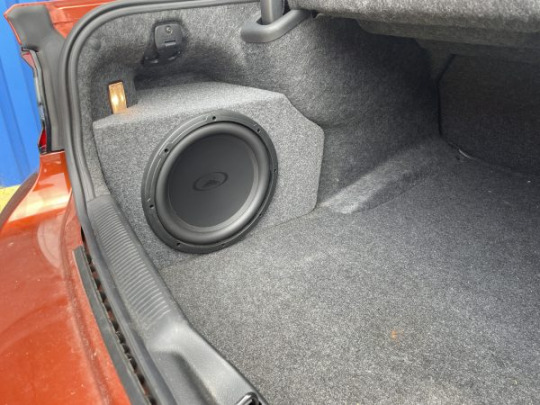

#stay tuned for part 2!#sony phones *are* great btw#they are sold in actual colors and they're full of cool features#their aux jack can double as a stereo input!!!
101 notes
·
View notes
Text
Burned

Brazier torches splayed over a cobwebbed spiral-case of stairs left abandoned. Only a singular blaze of resistance billowed; the lone-survivor, awaiting for rekindle owner to return. That ember's existence fought to prevent one descending into the chasm-passage below itself and joining the mad abyss, forevermore.
Radiant outlines of a shadowy figure were aligning, discovery in the dark... identity attempting to surface. Buried to the valley of suppression.
Pillaging glove's searched over a recently deceased Venomous assailant finding a room-key to an apartment. Returning to his feminine ally and surprisingly gestured bow, "I apologize, Kunoichi, one last request. Stow-away my client to safety, this key certainly belongs to a room of the deceased who never got a well-fare check, making the spot invisible. Likely, Hydo was given a time-contract, with him not attending, more will-follow for scent to the unfinished, unless. The hand is severed." A final murderous mission displayed, against his own Don's Estate, wielder of his sculpted cruel-design.
Chortle came between the sultry assassin, "This vixen, truly has you smitten." Hiding a pout behind a mask, "I'll agree but I might sink my paws, demanding repaid favor." Naturalness came as he stepped away.
She thought about forewarning gravitates again. Alas, every-time. He proved irrefutable, there's feelings she'd dwell for one who carried unbridled security and sheer discipline.
Upon his exit. The Killer Queen, pressed her lethal-nail's against the unconscious girl's throat near-puncture, a cat-like jealously that brought down her harbor. "Seems I've a rival with you I should eliminate, you girl." Flashed drama, revealed... "...But I'm interested in seeing if you're who sharpens, or dulls that particular blade." Retracting claws with playfulness then cradling her away.
...Meanwhile the Burned Shadow who was going to strike down his own feeder arrived, plethora of bodies of the Estate's men were already skewered to massacre.
Descending into the courtyard was further disarrayed butchery, was something political happening?
A lone-figure took pace across with Spectacle-glasses, another assassin, who glance-towards but held zero murderous intent, only a colorful-grin that shot across before Hoku. Then escaping beyond with a potent aura.
Seeker's ankles conflicted to turn for pursuit. However the interior Don's Estate men flocked out, "There's the perpetrator!" Instantly assuming him behind transgressions.
He withdrew steel from confines, rushing towards them it was his plans to eradicate them all-anyway. Just unexpected leg-work was done.
Stopping before a taller figure's he demonstrated a deft-dodge, slashing his blade from sternum to the giant's throat in a violent wave. Cutting down, losing himself again in red-rivers. Instinct-driving his manufacture-making, he moved elegantly like killing was floating atop waves, drifting effortlessly.
Reaching the main room. Everyone else laid erased, outside one and a missing Don.
The vigilant-survivor held blade, shook afraid; soaked to blood of peers, knowing he'd not cut-difference. <"..Y-y-you'll never find the Boss. You-fail fool!"> He'd tried mustering courage against this golden-eye, killer. Although pant's were soiled. He'd never be tortured of the intel within timely-matter, the boss would've escaped.
...Yet, Rozan the Star, engulfed meteor-resolve. An Uchigatana was thrown like spear through the last-alive, impaling the man to seat.
Hoku fetched chop-sticks of an empty ramen bowel. "We'll see." Came coldly in pitch. The poor-soul remaining couldn't predict the gruesomeness act or skill this assassin held. His head was expertly carved open; brain left to air, this Assassin with chop-sticks, played brain-operator, questioning. "Where is he?" Prodding at the hippocampus for answers.
"B-bb-ook cca-se." Forcefully pulled truth.
Assassin vouched, finding a secret-button, he mercy-slew the tortured informant.
One last life to take... This would end an inferno,
Extinguishing all to its beastly wake.

[Prev:Chapter]: Cold Adversity ~ ♪"Built for Sin"♪

#reader discretion advised#Ya'chi#Hoku Solaire#Killer Queen#Rokeia Solaire#Black Miracles#Mother of Dawn#Father of Shadow#scarlet destiny: volume 4#7 of 100#Rozan the 100 Stars#Creative Writing#tales of the goldbrand#will our dark flowers#ever become beacons?#still three chapters think of this arc depends on the sketch
20 notes
·
View notes
Text
Doflamingo - Debateable
Reader style - she/her AFAB
Time slot - After Hours
Client Name - @leakyweep
CW: clothed grinding, slight undress

You hiked your skirt up enough to straddle Doflamingo’s thighs without ripping the snug skirt. The action also showed off the thigh high stockings you were wearing, something that was appreciated by the amused man beneath you.
“You do realize your pants are going to get ruined.” You muse as he reaches down and undoes his belt, and zipper, letting his impressive length strain against silken boxers.
“It’s only fair that there be equal… protection.” He replies, amusement thick in his voice, as you settle your barely covered cunt against the stiff length.
“Mm, and the debate ends when you cum, right?” Your question is teasing, and he laughs.
“Once you do, my dear, yes.” He answers, leaving his hands on the arm rests of the chair. “I promise to be on my best behavior.”
You raise an eyebrow in obvious disbelief, before pressing into him and shifting your hips, your hands on his shoulders to help you keep your balance. “I doubt you even know was best behavior is, Mr. Donquixote.”
“Is that going to be our topic, this evening?” He muses, head tilting as he obviously leers at you from behind his glasses.
“Hardly.” You say. “Smile Incorporated has a vested interest in the continued research of artificial devil fruits, so, you’re going to debate against the expansion of such research.” You explain, shifting your hips against him, leaning forward a little and relishing the briefest hint of surprise on his face. It’s gone before you close the distance, but it was very clearly there.
“I’ll take the opposing stance of course.” You emphasize, nearly brushing your lips against his before you lean back a little.
A great devious grin splits his face, and you can hear his fingers tighten on the arms of the chair. “My, my. Devious little vixen, aren’t you?” His laugh rumbles in his chest for a moment before he begins. “Very well, then let’s begin by covering, quickly mind you, the dangers currently associated with the manufacture of the primary ingredient?”
“Ah, we could,” you agree. “I’m interested to hear your points, after the lengthy,” you emphasize your word by grinding against the entire length of his cock, “conversations we’ve had about all the safety measures put in place, I’m sure I can handle whatever you bring up.”
“You think I would’ve given you anything useful in such a short amount of time?” His voice has less amusement in it, and a more dangerous edge. You could tell when he finally decided to get serious with you like this.
“You think you’re the only source of information I have, Doffy?” You retort.
There’s a second of silence before the laugh that beats around in his chest breaks free entirely, filling your scarcely private corner of the main room for a second before he returns his attention to you. “After I win this evenings’ debate, young lady, I’ll be sure to,” he tilts his head down a little, letting his tongue slip across his lip slowly, “coax those sources from your pretty little mouth.”
One Piece Host Club AU drabble event runs through December 2023
#One Piece Host Club AU#December Drabble Event 2023#One Piece Fanfiction#x reader#reader insert#donquixote doflamingo
52 notes
·
View notes
Text
Can I Follow You Home? - Traitor Primarch Ver. (Modern AU)
If you ask Can I Follow You Home...
*: Character design from #projectepd, see character design pics here: ☆
Magnus
If you want to visit Magnus at his mansion in the New Capital, he might scrutinize your email with pursed lips for a while. From the subject line to the signature, and even the style and wording of the text—if you're lucky and what you propose happens to pique his interest, he might allow you to come by with a research proposal for consultation.
Magnus's mansion truly lives up to its original meaning. He won't greet you at the door; instead, he'll instruct you via email which room to go to, explicitly marking areas off-limits without permission. You have to tread carefully as soon as Amon opens the door for you, as you'll sense the space is filled with various antiques, rare books, specimens, and other collectibles. Whether it's hand-copied manuscripts with ink still fresh or prayer books adorned with jewels, the cabinets display a vast array, while numerous scrolls and carvings are sealed behind thick glass.
Amon will lead you to the reception room on the second floor, which, to be honest, leaves hardly any space to walk. The carpet is thick and soft, giving you the sensation of walking on sand. You can be sure there are cats in the house, as you spot cat hair on the couch and objects. However, unfortunately, the mansion is too large, and all the cats have hidden away. Magnus sits on the innermost sofa in the reception room, waiting for you to present your research report. During this time, you can smell the sweet aroma of wine and beeswax, a scent compounded with the heavy dust in the air, almost dizzying.
While he peruses your work, it's strongly advised not to let your gaze linger on areas of the room obviously concealed. If you were to discreetly lift a blanket or push a cabinet to reveal the modern lighting and the opposite cabinet, you'd find various movie props, first edition comics, signed posters by game designers, and perhaps even his secluded gaming den filled with numerous controllers, game boxes, and Blu-ray discs. If you were to really do that... Well, okay, okay, Amon, please show the guest out.
Perturabo
It's hard to imagine Perturabo introducing his house to anyone, but if there's anywhere in the world that brings him peace of mind, it's probably his own steel-reinforced safe house. This house is located at a secret address, accessible only through a long, narrow underground passage.
If you were to actually enter it, you might find yourself completely in the dark. That's because this place requires Perturabo's personal authentication to activate, and there's even an Iron Circle robot at the entrance—whether it can be activated or not is uncertain, but it looks quite formidable. Additionally, there's a rather intimidating set of exoskeletons, making you feel like you've stepped onto a movie set.
After navigating through various security measures, you finally reach an explosion-proof door. Behind this door lies a small room equipped with a separate escape hatch and water pump system, doubling as a precision mechanical workshop. From here, Perturabo can monitor all the activities in his main residence. It's like a doomsday bunker with comprehensive systems for any contingency. Here, Perturabo contemplates or crafts devices in absolute safety and silence, free from any possible disturbance, making it one of the few places where he can find complete tranquility. Sometimes, he spends entire weekends here alone, dedicating his time to constructing and manufacturing machinery. He even manages sleep on a mechanical bench or a hardboard bed. Then, at the beginning of the week, he returns to his regular duties, and of course, the items he manufactures here are never given to anyone.
If you find the space a bit cramped, you can activate the artificial scenery function on the multi-panel screens to display realistic landscapes. However, there's one obvious drawback: Perturabo hasn't equipped the house with any kitchen facilities, so if you're really hungry, you might have to make do with a few biscuits and water.
Fulgrim
Imagine visiting Fulgrim's mansion— which one, though? Let's go with the one he's been favoring lately. The walls of this mansion are painted in dazzling purple, and the satin on the velvet couches shimmers with a soft, enticing glow, but none of this compares to how he looks when he opens the door wearing his cozy housecoat. No more high-heeled boots or leather shoes, just bare feet adorned with a pair of fuzzy deep purple slippers. As you step inside, he'll surely ask you what music you'd like to listen to, and as you ponder which record suits this warm, radiant evening, he'll inquire about your drink preferences and if you'd like some snacks—too many choices might leave you a bit overwhelmed, but Fulgrim has already selected a few that he's perfected. Herbal tea, mille-feuille, a selection of classical recordings from the La Fenice Theater—the needle of the record player gently drops, and you never imagined you'd hear his collection in the home of this opera master.
You might find yourself sitting on a couch that's unbelievably soft, not as tidy as you'd imagine, adorned with dried flowers and fabric samples. But the pillows and cushions you hold emit delightful scents, and he promises to send you home with a sample of his handmade incense. And because the snacks are so delicious, you have to be careful not to eat too quickly. If you're full, you might explore the dressing rooms on the second floor—or should I say, the entire second floor is dressing rooms. Each room has floor-length mirrors and professional lighting fixtures, showcasing a variety of costumes, identical to those seen on the opera stage, down to the hand-sewn details. He'll show you the rooms for shoes and hats, the sheer volume from floor to ceiling is staggering, and you realize Fulgrim can clearly recall which designer or era each piece is from.
And if you're having a delightful conversation with him at this moment, he'd be more than happy to show you his clothing design sketches in the studio on the third floor. But as you step into the study, you might inhale sharply— the room is filled with numerous magazines and movie posters, all featuring his various personas. However, you can't help but admit that none of the pictures in the books seem as vivid and lifelike as the person standing before you.
Lorgar Aurelian
You initially prepared to visit Lorgar and expected it to be a public display, but you ended up at his private residence instead. He waits at the door for you before your arrival, claiming he anticipated this.
Lorgar's actual room is quite modest, even modern. People often forget his profession and find it hard to imagine his modern side. The room is so standard it could pass for a rental in the city, with some potted plants on the balcony. You gaze at him in his high-neck sweater, feeling a bit surprised—it's an uncommon sight.
There's still a faint scent of incense in the air, much like what you often smell in Word Bearer churches. Under Lorgar's gaze, you might need to change into slippers and shoe covers before entering. His bookshelf isn't stocked with books but scattered with wooden or metal ornaments, making you realize he has a habit of discarding or burning books after reading them. Interestingly, there are some modern-looking self-help and popular psychology books on the shelf, which Lorgar might explain are for Angron.
There are very few electronic devices in his home, not even digital clock screens, still relying on a very quaint chiming clock and occasionally using an old laptop and a fax machine for work. Judging by the dust, it seems Lorgar doesn't use them often. When you inquire about this, he mentions he still prefers handwritten letters. If you ask, he might even show you the Word Bearer seal. Interestingly, the ink pens and other items he uses daily are all handmade. As you approach the desk, you can smell a distinct classical ink scent. However, he expresses regret that he can't offer you any souvenirs—after all, his handwriting and signature are too precious, and you wouldn't know what to do with a true relic.
Angron
The idea of visiting Angron's home was rather nerve-wracking, to say the least. Honestly, if it weren't for the TV station's insane idea of doing this special program, chances are you wouldn't have had the opportunity to explore. However, what was likely aired on the show probably wasn't what you truly saw today. The Nuceria Wrestling League probably wanted to stage more stimulating scenes for the audience, so they might have taken away some items from here later and set them up elsewhere for shooting.
You shift your gaze back to the house in front of you, evidently arranged by Nuceria as Angron's residence, a luxurious apartment. Angron storms out of the bathroom, still dripping with water. He seems entirely unwilling to bother drying himself off. You can see water seeping onto the floor, clearly cleaned regularly by Nuceria's arranged personnel, replacing the vases and cabinets Angron smashes with new ones. No matter how roughly he treats the space he occupies, it returns to its original state after a while—you even feel that might be the reason for his anger.
You glance at the dining table, where Angron's previously endorsed cereals and protein bars lie. But you're pretty sure he doesn't eat them himself. Even the entire kitchen looks brand new, untouched by him, but you know another wrestler, Kharn, and their agent, Ms. Sarrin, sometimes use it to prepare simple meals.
The bathroom Angron just came out of doesn't have many bathing supplies; instead, it's stocked with bandages and painkillers you wouldn't typically find in a household. Next door is an entire home gym, a rarity, with a variety of exercise equipment dazzling the eyes, and the battered punching bag makes you shudder. Angron would smirk and say this place is just for show, with only the punching bag being somewhat useful. His real training is obviously in a more professional gym, and this place is probably just an assumption made by Nuceria.
You're surprised to see a cramped compartment, seemingly originally used as a small storage room. But when you discreetly open the door, you discover a hidden world inside. There are many scribbled to-do lists and tips from counseling centers, and a few crumpled manuals on the table. There's a pen holder made from a crushed soda can, with two or three stubby pencils inside. Before you can figure out what exactly this place is for, Angron grabs you by the scruff like a rabbit and drags you out.
Konrad Curze
In a sense, his home could even be considered a tourist attraction—if you're a fan of urban legends or folk horror radio shows, you've probably heard of the infamous haunted mansion at 50 Berkeley Square. Its notoriety isn't just historical; it's also connected to Konrad Curze. Some say he lived there, while others claim Curze himself is the source of the eerie tales about the mansion... Urban legends only get more mysterious as they circulate. If you're a social media influencer or a haunted house explorer, or even if you're looking to invest in real estate and have enough courage, perhaps you could try entering.
Of course, the faint-hearted should go during the day, but the brave, unafraid of death, can choose nighttime. The atmosphere and the gusts of fog alone are enough to make one gulp down a pot of tea, and as you shiver while trying to push open the mansion's front door, only to find it immovable, you might need a helping hand or a ladder to climb through the broken window on the east side—actually, Curze usually exits from here; he doesn't have much of a concept of using the front door, but he's rather fond of the gargoyle on the roof.
There are appliances in the house, and you can even try turning on the lights, but you must be wary of potential electrical hazards, as you have no idea where the wires are connected, definitely not to code. There are suspicious marks on the wooden floorboards—let's refuse to ponder whether they're claw marks or bloodstains, carefully avoiding all hazardous areas, and you'll find that the mansion is like a massive secret chamber or maze. Many of the upholstered or leather furniture pieces are either covered in dust or in a state of disrepair. A large portion of them is even strewn across the floor, blocking your path. After finally maneuvering past the creaky floorboards and reaching the kitchen, you're pleasantly surprised to find that not only are the lights functioning, but the fridge is also plugged in! However, after noticing the suspicious traces seeping from the fridge and cabinets, perhaps it's better not to open them...
You turn to look at the kitchen utensils on the countertop—they're quite new, most likely brought over by Fulgrim, who is always dedicated to getting Curze's life back on track. You're certain the bath salts strewn everywhere in the bathroom and the torn bath bombs are also his doing. As you contemplate further exploration of the other rooms in the house, Curze, who has suddenly appeared on the sofa, emits a hissing sound, forcing you to stop in your tracks. He blends completely into the darkness, using the unplugged wires to tell you he doesn't like too much light in the house. Curze curls up on the torn sofa, the once black and yellow fuzz now darkened and scattered from the overturned cushions.
Mortarion
If you're one of his trusted Deathshroud laboratory assistants, you might get the chance to visit his private residence. You'd disembark in the backyard, not at the front gate. Upon entering, you might initially think it's a karesansui garden. However, upon closer inspection, you'd discover that the tiered flower beds and foliage are actually arranged in intricate geometric patterns, following the mysterious Fibonacci sequence found in nature. You'd notice many plants with peculiar shapes or overly vibrant colors, and your intuition would tell you to stay far away from them. Mortarion breathes in the air of the courtyard through his mask, his fingers almost grazing the plants.
After circling the garden, you'd enter his home. It's eerily quiet, to the point where you can hear the chirping of insects from the courtyard. Mortarion is wearing nothing but a thin plain robe indoors, which obscures his overly pale skin, giving off an unsettling chill.
He would draw the curtains when the sun rises, shrouding the interior in dim shadows. You might find yourself unable to resist looking at the printed numerical sequences on the walls of his room, as well as the insects and plant specimens framed in display cases. And the darker the environment, the more lifelike they appear. If you stare long enough, you might almost feel as if they're about to flutter their wings at any moment. As you walk along the walls, you'd come across a fish tank illuminated only by scenery and a dim green light, devoid of any fish. Just as you can't help but wonder what happened in there, you catch a faint whiff of formaldehyde from the closed door nearby.
At that moment, dusk sets in. Mortarion suddenly pulls back the curtains, startling everyone present. Yet, he casually produces homemade wine from the courtyard. If you're lucky enough, you might be treated to these drinks alongside other visiting Deathshroud members—you all instinctively don't think to refuse such a possibility.
Horus Lupercal
Horus's current residence is the result of a black market deal after a fire many years ago, but now it's deemed 'completely legitimate and legal,' with records in the Luna Wolves' archives even documenting the hefty property taxes they dutifully pay.
The overall style of the house bears a striking resemblance to the Wolves' old home in Sicily, likely because Sejanus and others brought over a fair amount of furniture from there. They even had a massive oven installed for occasional nostalgic pizzas or bread reminiscent of home. Whenever Horus needs to meet privately with the Mournival, it's almost always held in the ground floor of this house. They would sit around a long table, surrounded by paintings by artists who once owed substantial debts, hanging on the walls and ceiling. Torgaddon once quipped that while meetings in this environment were bearable, eating was out of the question—prompting an immediate reprimand from Abaddon.
If you're one of Horus's trusted confidants, you might have the chance to see the final painting in that series, displayed alone in his living room. Surprisingly, his room doesn't entirely adhere to the style of the rest of the house; it's more minimalistic, with fewer decorative furnishings, featuring only a bookcase, a bed, a clothes rack, a drinks cabinet, and a table. The bookcase holds a collection of epic, literary, and historical works. If you catch him in a good mood, he might allow you to pour a drink or help him hang up his suit jacket. Whether to add ice, how much ice to add, whether to send it to the dry cleaners, and where to hang it all become matters of importance. And if you get it right, Horus might relax a bit, loosen his tie, and share the story behind the painting with you. But the test has only just begun; either stay silent and listen carefully or ask the most precise questions to help him tell the story he's told a thousand times before. And if you happen to mention some keywords he doesn't like, then all efforts will be in vain. Remember, caution is key.
Alpharius
You walk into a room.
As for what kind of room it is, you feel it's a bit like an employee dormitory, yet also reminiscent of a single room in a budget hotel.
It looks completely fine. Neat, clean, with items that are ninety percent new, not overly pristine to make it difficult to use, yet appropriately lacking a sense of warmth. You attempt to turn on the lights in the room, only to discover that all the power sockets perfectly match your lifestyle, requiring almost no additional adapters or special interfaces. Speaking of interfaces... where is your phone? Realizing this, you glance at the coffee table and the cabinet above it, noticing that the room is not equipped with any telephones.
You suspect your phone might be in the pocket of your coat, so you try to open the wardrobe in the room. Inside, there are three hangers, each holding your outerwear for different seasons, perfectly matching your size and dressing habits. However, they are all brand new, without any signs of being worn.
Despite thinking it's impossible, you still check the pockets of these clothes. In the inner pocket of your winter coat, you find a business card. There's only one name on the card.
You feel a dizzy spell. How long has it been since you last ate? A wave of weakness washes over you, and you collapse onto the unwrinkled bed.
You wake up to the sound of your own phone ringing. As you regain consciousness, you find yourself lying in your most familiar bed. The scent, the pillows, the blankets all make you feel incredibly safe. You sigh with relief, realizing you've just had a strange dream - but it's all over now, isn't it? You pick up your phone, intending to freshen up.
After a moment, you realize there seems to be something under your phone.
It's a business card.
#primarch headcanon#horus lupercal#fulgrim#mortarion#perturabo#konard curze#alpharius#lorgar aurelian#modern au
39 notes
·
View notes
Text
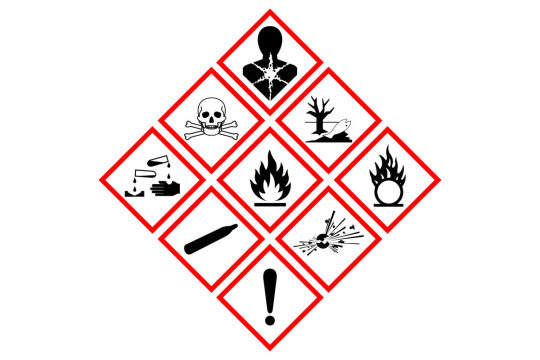
Laboratory Signage and Labeling
Proper labeling of hazards is crucial for good laboratory safety, as well as other labels about required PPE or prohibited substances and labels indicating safety equipment, among others. Exact labeling will vary from country to country and organization to organization for many things, but in general, pictograms are favored over text. Certain hazards are covered by the Globally Harmonized System of Classification and Labeling of Chemicals (GHS) created by the UN; pictograms from the GHS are shown above. For other hazards (such as biological hazards), requirements (such as laser safety glasses), or location-specific labels (such as where the first aid kit is), organizations or countries may come up with their own symbols.
Chemical labeling can again vary, but the GHS requires pictograms, signal words (e.g., "danger"), and more specific hazard statements and identifiers. It is common practice that when new chemicals are mixed or created in the lab (or otherwise in containers not from any manufacturer) that the full name of the chemical be written whenever possible (e.g., sodium hydroxide instead of NaOH) to prevent any confusion or uncertainty. In many cases, for individual laboratories, signage includes emergency contact information for the person(s) responsible for the laboratory.
Sources/Further Reading: (DuraLabel) (Lab Manager) (Oklahoma State University) (52 Lab safety symbol examples) (The GHS) (OSHA) (Chemicalsafety.com)
(Image source)
19 notes
·
View notes
Text
I have purchased.. a PAN!!!
I did a whole lotta research, spoke to my sister a lot, did more research, price compared, and finally decided on a pan: the All-Clad 10" fry pan with lid. Ideally, I wanted a glass top lid, but I could not find everything I wanted at a price I was interested in paying. Anyway, pan!

Why did I go for this pan? All-Clad makes some of the best stainless steel pans on the market. If I wanted the best, I'd actually not be getting stainless steel, but the Hestan Nanobond. However, their fry pan is nearly $500 (CAD) and doesn't come with a lid. Given the amount of cooking I do, even if i were to never replace that pan in my life, I just don't feel I need a pan that expensive right now. All-Clad's pans are also on the pricier side compared to some other pans, but at $150 (CAD) for this particular pan, I'm not fussed about the price. I know I'll be keeping it for a long while.
Now, why not go with non-stick pans? Well, to be honest, I did want one. I really love the look of the GreenPan pans, they did a collab with Stanley Tucci, which I don't care about celebrity anything, but this line has such a beautiful teal I was so, so tempted to get it. However, the more research I did, the less I wanted to spend the money. (The teal covered fry pan is $260 (CAD) and only comes in one size, and it's a bit too big for my burners) While GreenPan does have a good mission about sustainability from what I read from them, the fact of the matter is regardless of this, non-stick pans have a much shorter lifespan than pans without a non-stick coating. From what I read, the longevity can be from a few months to up to five years, and i definitely was using my old non-stick far longer than that and is alarming to think about, but also, that isn't that long. And that's for traditional non-sticks. Apparently ceramic non-stick, what GreenPan's pans are, last for an even shorter amount of time. The coating erodes, get scratched, is sensitive to too much heat, and while you can recycle pans, apparently because the coating is difficult to remove to recycle many non-stick pans still end up in the landfill. Additionally, with ceramic non-stick specifically, it's only been around since 2007 and while GreenPan and other manufacturers aren't using PFAs or PFOAs (one of them is outlawed in the US now, but I forget which, whatever Teflon is), the chemicals they do use to make the non-stick coating has not been tested extensively to be assured about the safety of the coating, and there are concerns over some of the chemicals in particular.
I told a friend earlier I feel like I know so much about pans now, I would like to know less about them. But, I am happy with my choice. I think All-Clad makes good stainless steel pans, and based on the research I did, they make safe pans for my health.
Anyway, now I have to wait for it to arrive. I could only find this one pan at Williams Sonoma, and they tell me it'll arrive in July. Oh well, it's the one I want after many hours of research that my eyes were incredibly annoyed with me this week. Maybe once it arrives I'll talk about how it feels to cook with!
9 notes
·
View notes
Text
"How much safer has construction really gotten? Let’s take a look.
Construction used to be incredibly dangerous
By the end of the 19th century, what’s sometimes called the second industrial revolution had made US industry incredibly productive. But it had also made working conditions more dangerous...
One source estimates 25,000 total US workplace fatalities in 1908 (Aldrich 1997). Another 1913 estimate gave 23,000 deaths against 38 million workers. Per capita, this is about 61 deaths per 100,000 workers, roughly 17 times the rate of workplace fatalities we have today...
In a world of dangerous work, construction was one of the most dangerous industries of all. By the 1930s and early 1940s the occupational death rate for all US workers had fallen to around 36-37 per 100,000 workers. At the same time [in the 1930s and early 1940s], the death rate in construction was around 150-200 deaths per 100,000 workers, roughly five times as high... By comparison, the death rate of US troops in Afghanistan in 2010 was about 500 per 100,000 troops. By the mid-20th century, the only industry sector more dangerous than construction was mining, which had a death rate roughly 50% higher than construction.
We see something similar if we look at injuries. In 1958 the rate of disabling injuries in construction was 3 times as high as the manufacturing rate, and almost 5 times as high as the overall worker rate.
Increasing safety
Over the course of the 20th century, construction steadily got safer.

Between 1940 and 2023, the occupational death rate in construction declined from 150-200 per 100,000 workers to 13-15 per 100,000 workers, or more than 90%. Source: US Statistical Abstract, FRED
For ironworkers, the death rate went from around 250-300 per 100,000 workers in the late 1940s to 27 per 100,000 today.
Tracking trends in construction injuries is harder, due to data consistency issues. A death is a death, but what sort of injury counts as “severe,” or “disabling,” or is even worth reporting is likely to change over time. [3] But we seem to see a similar trend there. Looking at BLS Occupational Injuries and Illnesses data, between the 1970s and 2020s the injury rate per 100 workers declined from 15 to 2.5.

Source of safety improvements
Improvements in US construction safety were due to a multitude of factors, and part of a much broader trend of improving workplace safety that took place over the 20th century.
The most significant early step was the passage of workers compensation laws, which compensated workers in the event of an injury, increasing the costs to employers if workers were injured (Aldrich 1997). Prior to workers comp laws, a worker or his family would have to sue his employer for damages and prove negligence in the event of an injury or death. Wisconsin passed the first state workers comp law in 1911, and by 1921 most states had workers compensation programs.
The subsequent rising costs of worker injuries and deaths caused employers to focus more on workplace safety. According to Mark Aldrich, historian and former OSHA economist, “Companies began to guard machines and power sources while machinery makers developed safer designs. Managers began to look for hidden dangers at work, and to require that workers wear hard hats and safety glasses.” Associations and trade journals for safety engineering, such as the American Society of Safety Professionals, began to appear...
In 1934, the Department of Labor established a Division of Labor Standards, which would later become the Occupational Safety and Health Administration (OSHA), to “promote worker safety and health.” The 1935 National Labor Relations Act (NLRA), which legalized collective bargaining, allowed trade unions to advocate for worker safety.
Following WWII, the scale of government intervention in addressing social problems, including worker safety, dramatically increased.
In addition to OSHA and environmental protection laws, this era also saw the creation of the Consumer Product Safety Commission (CPSC), the National Highway Traffic Safety Administration (NHTSA), and the National Institute for Occupational Safety and Health (NIOSH).
OSHA in particular dramatically changed the landscape of workplace safety, and is sometimes viewed as “the culmination of 60 or more years of effort towards a safe and hazard-free workplace.”"
-via Construction Physics (Substack newsletter by Brian Potter), 3/9/23
#construction#osha#workplace#workplace safety#workers rights#labor rights#occupational health#nlra#collective bargaining#united states#us history#labor unions#industrial revolution#this is why unions and regulations are so fucking important by the way#if you have not studied late 1800s and early 1900s labor history in the US#you really can't grasp how incredibly dangerous things used to be#and how much proof we have that corporations suck#government regulations
90 notes
·
View notes
Text
this is the most genderfluid car (derogatory)
, reads the caption this picture of a ‘94 Oldsmobile Cutlass Ciera Wagon S was submitted to this blog with.
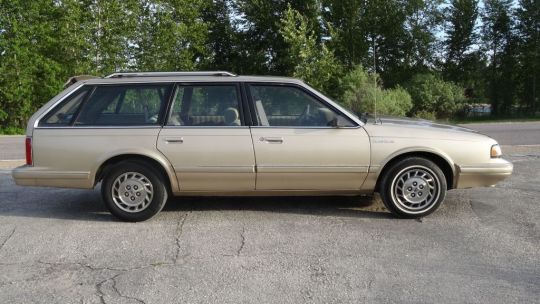
And while I would indeed like @sapphicshart to elaborate on why this car would be so genderfluid and why in a derogatory way, and perhaps appreciate how they reused the window triangles from the regular one at the rear end of the body, I feel that must make way for my first reaction upon the claim of “most genderfluid”:
haha.
Hahahaha.
HAHAHAHAHHA.
MUAUAHAHAUAHAHAHAHAHAHAHAHHAHAHAAAAAAAA.
Dear friend, prepare to get absolutely motherfucking BODIED.
This is the 1982 Nissan Pulsar NX (Pulsar EXA in Japan and Australia), and it’s not the car we are interested in.

The Pulsar NX was a way Nissan devised to get a more youthful and exciting coupe out of the underpinnings of the Nissan Pulsar/Sunny/Cherry (or even Holden Astra, if you’re feeling weirdly Australian), …conventionally unappealing little sedan and hatchback. Ah, right, I’ve still not made the body styles master explainer - let me brief you very quick. The above is a coupe, a car with two doors and a trunk compartment that is separate from the cabin. When the doors are four, it’s what you see below, a sedan.

Whereas a hatchback is one with a rear hatch that contains the rear windshield, making the trunk compartment part of the cabin.

See what I meant with the “conventionally unappealing”, eh.
Well, in 1986 the base Pulsar/Sunny/Cherry/Sentra/so on received an update, and thus the Pulsar NX based on its guts was updated with it.
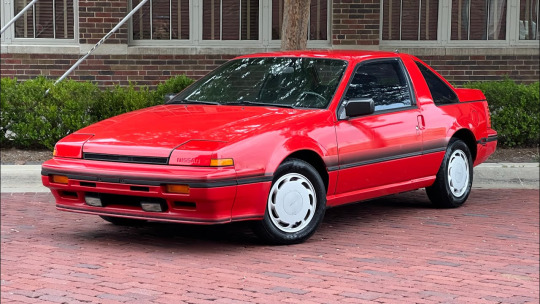
And if your brows are furrowed by unfamiliarity and not by the painful realization of how hard our poor submitter is about to get pulverized, you must understand that this car’s body style is… rather unique.
In late ‘60s America, word started spreading that the Department Of Transportation would ban convertibles due to the awful lack of shit between passenger heads and pavement when they decided to change side - thus began the popularity of “targas” like this here NX (though manufacturers called them a lot of different names because Porsche copyrighted that word).
In a targa, instead of both roof and rear windshield all folding down behind the cabin, the roof is a solid panel (or, as in this case, two) that is removed and stored away and the rear windshield stays there, on the rear structure that remains at the service of body rigidity and occupants safety. And personally that feels extremely genderfluid to me.
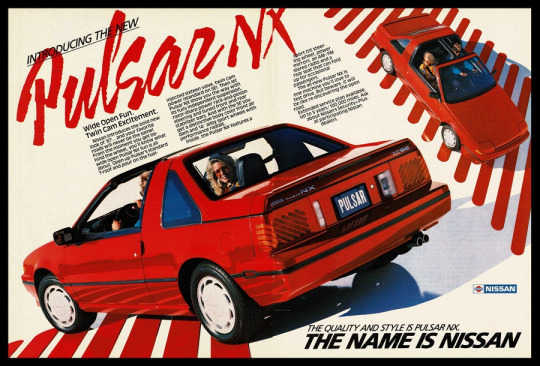
But of course, there are many targa coupes, so this would not be such a peculiarity. But the thing is, while this car has two doors and a trunk compartment separate from the interior and thus a coupe, it can also be argued a hatchback since it has a hatch that includes the rear windshield.
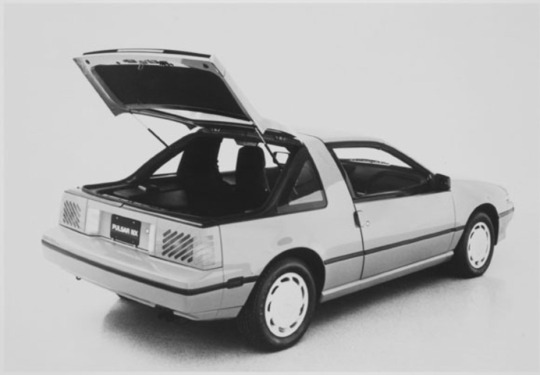
But why in tarnation would they design a rear hatch like that when, since it doesn’t create any more room above the trunk, it has no cargo space advantage? Well, remember how one key difference between targas and convertibles is that in the former the rear windshield stays in place? Well, here it does stay in place, if you want to. If you don’t, though, you just take it off.

So the Pulsar NX is a coupe that is also a hatchback and a targa and a cabriolet. Except that now, as you can see, the rear compartment is open. So arguably it’s also a pickup - or, if you will, a ute. (It’s doing that weird thing it does sometimes with post submissions where it keeps me on the old editor where I can’t change text color so please pretend that link is the trademark ‘link to a related things-about-cars-in-posts post’ blue.)
But then you’d at least want a canvas cover or something just in case it rains and your rear passengers and/or cargo don’t like rain, right? So indeed, here’s the optional canvas canopy.
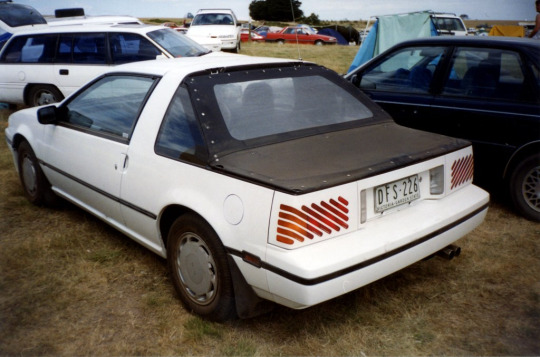
Meaning it could also have both a fixed glass rear windshield and a folding plastic one, making it both a hardtop convertible and a soft top one.
But what if you wanted to transport too much cargo to fit under the hatch -or the canvas cover- but you still wanted to have it protected, as you could do in a ute with a rear canopy?
Well, folks, I truly saved the best for last.
Because this thing is not just a coupe, a hatchback, a targa, a soft top convertible, a hardtop convertible, a pickup and a ute. It’s also a shooting brake. (Again, pretend that’s blue.)
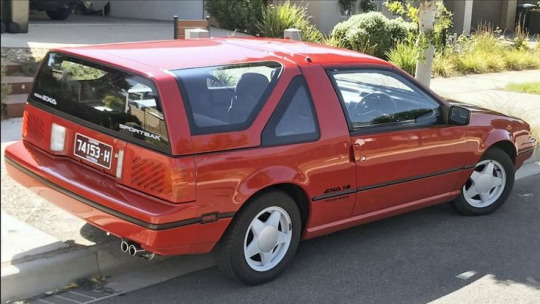



You see now why the rear hatch hinged like that.
So while this is a post about a most [specific sexual identity or orientation] car, I am not, as per tradition, offering other options nor a vote between them, because democracy does not apply to matters of fact. (And also again I’m stuck on the old editor.)
But of course, if you want to participate in the creation of any future installments, hop on over into the Discord server linked in my pinned! It’s got glowing reviews :)
31 notes
·
View notes
Note
Longtime lurker, hoping you can help me out.
I'd like to purchase a gas mask that is available for say...under $200-300...and compatible with aiming a rifle?
Can you suggest a couple of models that are affordable and easily obtainable?
I'm also (seperately) looking for a low cost self-contained (battery driven supllied air) full-face respirator for painting or spaying pesticides but the cost of the 3M system has kept me from taking the plunge. I find half masks or disposables really uncomfortable to breath through. Any suggestions?
That depends on a lot of things - let's start with the most important one, are you wanting to buy new or are you experienced enough to know what to look out for with surplus items?
Assuming you live in the U.S., imo the best option for most tactically-inclined individuals are ex-police Avon C50's; They sit smack dab in the middle of the pricepoint you described (going for $250+ on average) and they meet 80% of the criteria for what I personally believe a modern "tactical" mask (not just military) should encompass:
Panoramic eyelens with a wide ecosystem of lens outserts
Optical insert capability
Comms and/or Voice Amplifier-Capable
Mesh skullcap-type head harness with low-profile buckles for helmet integration
Butyl rubber and glass-filled nylon construction
Common, standardized drinking adapter
Threaded for Rd40x1/7" NATO Canisters for greater flexibility of protection (i.e.; using canisters intended for specific threats instead of just general purpose CBRN)
Left and right-hand capable side ports
Interchangeable inner nosecups for custom sizing based on individual facial ergonomics
The only thing it really lags behind in is having poor passive voice communication (no voice diaphragm, just the outlet valve), as well as poor moisture drainage (you will have to lean forward to drain any sweat, spit, etc out the outlet valve rather than it draining naturally)


All gas masks are generally going to put you at a disadvantage as far as aiming a rifle, and even masks designed for improved rifle ergonomics like the Avon FM53/54 still give a massive amount of stand-off when attempting to look down your sights, so I'd definitely hop on the bandwagon of tall optic risers if gas mask usage is a legitimate consideration.
Other excellent surplus options include the older Avon FM12, Scott/Kemira M/95 (or more realistically, the Scott M110 if you can find them; the M/95's drinking system is hard to get adapters for), or even MSA Millennium or surplus M40A1 Protective Masks are all viable options with a fair amount of aftermarket support.
As far as buying newly-manufactured masks, you're going to be cutting above the $300 mark - Avon sells their C50 (and FM50, which is the same but with proprietary cartridges) at an MSRP of $500
Mira Safety is a brand you've likely heard of, who are mostly known as a redistributor of gas masks manufactured for them by Czech firm Gumarny Zubri. Mira as a company is incredibly underhanded and shady - they make a lot of false claims about who they sell to and the capability of their products, and not to mention their ad campaigns are the most blatantly mudslinging/misinformed.
Objectively the only thing that Mira/GuZu masks really shine at is having slightly higher quality rubber and superior passive voice comms and downward moisture drainage over Avon designs. They fail at basically every other aspect. However, they do work and they are cheaper if buying brand-new masks is a requirement for you.
I sadly don't have many suggestions as far as commercial/industrial PAPR units - I know a lot of those are surplussed by the pharmaceutical/medical industry, so I'd browse options, get to know them and spend time obsessively browsing ebay for various models and knowing how to tell when they're complete and serviceable.
Oh and one last thing -
P3-rated Particulate Filters are your best friend if all you realistically expect to face off against is tear gas and nuisance dusts. Particulate filters don't really expire since there's basically no chemicals that break down and can be stored almost indefinitely provided there's no moisture to foul the filter element.
40mm threaded P3 cartridges made by 3M, Racal, MSA etc are super common on the industrial surplus market and can be had in bulk for reasonably cheap, especially as "expired" lots.
8 notes
·
View notes